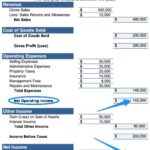Content
Inventory, in general, can be an important balance sheet asset because it forms the basis for a business’s operations and goals. It can also potentially be used as collateral for credit borrowing. A manufacturer’s beginning inventory may include raw materials and individual components, as well as items in production and finished goods. A retailer’s beginning inventory includes all products https://kelleysbookkeeping.com/ available and ready to be sold to customers. For example, suppose a company’s beginning WIP inventory costs $15,000, their manufacturing costs $50,000 and their cost of finished goods is $45,000. Microsoft authors write that this method looks to determine the value of a product or job by using the percentage of completion to calculate the proportion of estimated total costs.

The higher the inventory turnover ratio the better inventory is turning over and being utilized. In addition, beginning inventory is an important component of inventory accounting for both internal and external purposes. (More on that soon.) It is also part of the formula to determine cost of goods sold (COGS), which, in turn, helps predict a company’s profitability. And, of course, profitability, along with growth, is a key indicator of a company’s financial health and long-term prospects. It’s a good idea to keep track of your inventory over the entirety of the fiscal year, but ending inventory is particularly important to calculate. Not only in order to ensure your actual stocks match with your sales and purchases over the course of the the accounting period, but also because this is often required in the case of an audit.
How to Calculate Beginning Inventory
While this formula can help you calculate the inventory you have on hand, it doesn’t give you the full story. So, if you already have a different inventory management system in place, don’t feel like you need to suddenly switch. In this example, your average inventory is $8,336 worth of product on hand.
- The beginning inventory like an expense, when it is overstated the profit is understated.
- Placing an extra emphasis on reducing the inventory could weaken the production flow, Indeed writers explain.
- With a tech-enabled third-party logistics (3PL) company like ShipBob, you can log in to your inventory management system and access real-time inventory counts.
- Calculation of a business’ average inventory in a particular accounting period is the second important use of opening inventory.
- Inventory turnover and inventory days are two of the most important balance sheet ratios involving inventory.
- Or you might be dealing with more complex inventory such as both assembled computers and their component parts.
If some of the purchases were added to inventory, they are not part of the cost of goods sold. Once you know your inventory turnover rate, you can calculate your average inventory period. That tells you how long it takes to turn your inventory into those ever-important sales. A high inventory turnover rate means you’re selling through your inventory quickly. As a result, you don’t have a lot of old, unsold products taking up space inside your company. It also means that your products are in demand and you’re doing a good job selling them.
Who Should Use the Average Inventory Formula?
This company further produced 1000 candles in their next year of production. Besides inventory turnover, numerous other financial metrics can be calculated using either the closing inventory or beginning inventory. However, the opening inventory gives a more accurate average compared to instances where ending inventory is used.
Though they are important for production, they do not go into the final good. For instance, if you are a manufacturer of fruit juice, spotting machine grease in your product would cause a great uproar among consumers. Nonetheless, the modes of operation for these two kinds of businesses are completely different. To save you time, we built a beginning inventory calculator just for you.
History of IAS 2
You will need the beginning inventory in the financial analysis to determine inventory turnover. When calculating the cost of goods sold, whether as a retailer or a manufacturer, opening inventory is a fundamental part of the equation. Ideally, it is the starting point as you add all the purchases made to the beginning inventory of that given then less the closing inventory. For manufacturing firms, the process is a bit complicated as work in progress is involved. Since the opening inventory will be utilized either in part or wholly during the current accounting period, it is a company’s current asset.
- Thus, accurate and up-to-date beginning inventory data is essential for businesses to generate accurate COGS information, which can then be used to calculate gross profit.
- The cost of purchases made for the inventory is added to the value of the stock at the beginning of the selected period.
- Then, at the end of January, you had an ending inventory of $6,000.
- Different businesses will, of course, count inventory in different ways.
- This is where beginning and ending inventory calculations are involved.
- For example, suppose a company’s beginning WIP inventory costs $15,000, their manufacturing costs $50,000 and their cost of finished goods is $45,000.
Balance sheets and other internal accounting documents include the beginning inventory value. This information can track the company’s financial health and make decisions about future investments. Similarly, beginning inventory can be essential in determining the amount of taxes a company owes. Shopify automatically syncs stock quantities as you receive, sell, return, or exchange products online or in store—no manual reconciling necessary.
There are multiple valuation methods that can be used depending on business size and needs. Inventory forms the basis for the cost of goods sold (COGS) calculations which constitute the total cost a company incurs per unit. Companies seek to have the lowest cost of goods sold and the highest optimal selling price in order to make the greatest profit per unit. As such, gross profit and its key component, cost of goods sold, serve as one starting point for inventory metrics.
At the start of the fiscal year (January 1st), Gadget World’s beginning inventory is valued at $50,000. But if you already know the beginning inventory and ending inventory figures, you can also use them to determine the cost of goods sold. At first glance, calculating beginning inventory values seems fairly simple. However that does not mean it is not vital to all ordering and fulfillment operations. The real value comes from using these values to make smart business decisions. They’re given the role of reporting different inventory metrics, especially the beginning inventory.
What is the difference between ending inventory and beginning inventory?
Earlier we stated that to calculate average inventory, you need only divide the sum of beginning and ending inventory by two. Ending inventory is calculated by summing up your beginning inventory and net purchases and extracting it from your cost of goods sold (COGS). Bginning inventory, on the other hand, is calculated by adding your COGS to ending inventory and extracting the result from purchases. Beginning inventory is necessary for internal accounting documentation.

Inventory levels will nearly always fluctuate, and that can be a good or bad sign for your business. A decrease in beginning inventory values could indicate particularly strong sales during a period, or a critical problem in the overall supply chain. Conversely, raising values in beginning inventory Beginning Inventory Definition could be the result of intentional preparation for increased product demand, or a drop of in market demand for certain inventory items. Knowing which of these scenarios is the case is vital for the success of any B2C or DTC operation, and it all begins with knowing your beginning inventory.
Understanding Beginning Inventory
Instead, you’ll need to physically count the items on hand at the end of each accounting period. Then you can use those numbers to plug into the formula above to find your average. If you have a low inventory turnover rate, it’s a sign that you’re not selling through your inventory quickly enough. With a low rate, you might end up stuck holding products that are no longer in demand and losing money.
- For this reason it’s sometimes referred to as closing inventory, and should match the beginning inventory for the accounting period that immediately follows.
- As such, gross profit and its key component, cost of goods sold, serve as one starting point for inventory metrics.
- Any change to beginning inventory compared with the previous period usually signals a shift in the business.
- On the other hand, businesses that deal in physical goods, whether they are finished products or raw materials, must have their inventories up-to-date at all times.
- Assuming you run a retail business, you may only be handling finished products with extremely few value-addition undertakings before selling them to consumers.
